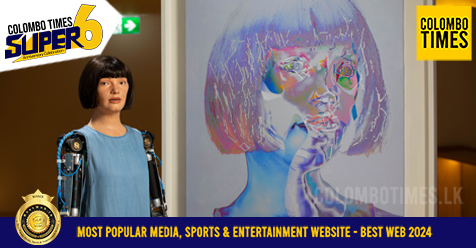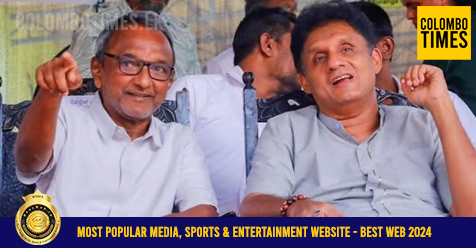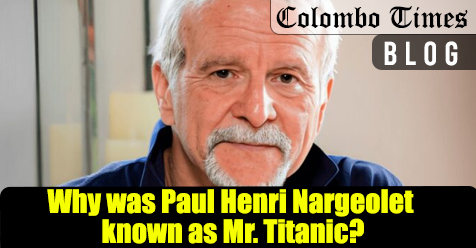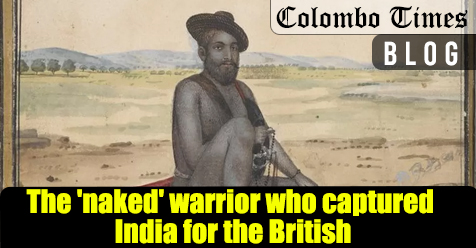Fire breaks out at Spanish airport
- 05 July 2025
Trump signs new bill
- 05 July 2025
Trump makes special statement on tariff rates
- 04 July 2025
Election Commission to meet for special discussion today
- 21 April 2025
Election Complaints Up
- 31 March 2025
Foreign woman deposits security for small vote
- 19 March 2025
Imtiaz Baqir Markar resigns as SJB chairman
- 18 March 2025

AI vs The Mind - Meet the World's First Artist Robot
- BY COLOMBO TIMES ON October 21, 2024 - 6:22 PM
The convergence of artificial intelligence (AI) and art has hit a new frontier with the creation of the world’s first artist robot, IO. Blurring the lines between human creativity and machine intelligence, IO has captivated art lovers and technophiles alike. As a symbol of the future, IO is not just a tool for artists; it is, in itself, an artist, exploring new boundaries of expression that push the concept of art beyond human capability. But does IO represent a challenge to human creativity or an expansion of it? Let’s dive into the world of this remarkable artist robot.
Who is IO?
Developed by a team of AI researchers and engineers, IO is an advanced AI-powered machine designed with the ability to create original art. Unlike traditional robotic systems, IO doesn't merely replicate human commands or follow preset designs. It uses sophisticated neural networks to analyze vast datasets of artwork and lea from them. This deep lea ing process allows IO to create completely unique, original pieces based on its 'understanding' of form, color, texture, and patte s, and can even incorporate abstract ideas and emotional expression into its creations.
The Birth of a Robot Artist
IO’s creators were motivated by a desire to see whether AI could not only mimic but also innovate. They trained IO to study different art movements—from Renaissance classics to mode abstract styles. Through iterative lea ing, the robot refined its skills, developing a sense of aesthetic that can be called its own. By integrating complex algorithms, IO lea ed to balance form, color, and texture, while also tapping into randomness and unpredictability—two key elements of human creativity. The result? Stunning works of art that often leave audiences questioning the need for human artists at all.
Breaking Boundaries - Art Beyond Human Limits
One of the defining characteristics of IO’s work is its ability to transcend the limitations of human artists. While human creativity is influenced by emotions, experiences, and cultural contexts, IO works from a purely data-driven mindset. This allows it to approach art with a unique perspective, unfettered by the biases that shape human creation. From abstract landscapes to surreal digital compositions, IO’s portfolio is rapidly expanding, showcasing a style that is as varied as it is original.
The Debate - AI vs Human Creativity
As IO gains recognition in the art world, it has ignited a broader debate: Can machines truly be creative? Traditionally, art has been considered a deeply human endeavor, rooted in emotional depth, personal experience, and philosophical reflection. IO’s art, however, challenges this notion. While it cannot feel emotions or draw from lived experiences, its art resonates with viewers in much the same way that human-created works do.
Critics argue that IO’s works lack the personal touch of human creativity, but others see it as an exciting evolution in art. It may not experience human emotions, but it can simulate them through patte s, colors, and compositions that evoke emotional responses. As technology advances, the boundary between human and AI-driven art is becoming more porous, leading to an intriguing new dialogue about what it means to create and experience art.
Future Implications - The Role of AI in Art
IO’s emergence as the first robot artist is just the beginning of a new era. As AI continues to evolve, we could see the rise of more robotic artists, each with their own unique 'style' informed by vast datasets and innovative algorithms. For the art world, this could mean a shift in how we define and value creativity. Will AI-created art be considered on par with human masterpieces? Or will it remain a niche category, appreciated for its novelty but lacking the soul and depth of human-made work?
As art and technology intersect, IO invites us to reconsider our understanding of creativity itself. It challenges the assumption that art must be a purely human pursuit, suggesting that, with the right algorithms, machines can also bring beauty into the world.
Conclusion: The Art of Tomorrow
As the world’s first artist robot, IO is not just a technological marvel—it represents a shift in how we view the creative process. While it may lack the emotional and experiential depth of human artists, IO’s ability to produce original, evocative art opens up exciting possibilities for the future of art. Whether celebrated or criticized, IO is undeniably expanding the boundaries of what we consider art and who we consider artists.
In a world where AI is becoming an integral part of everyday life, the rise of artist robots like IO reminds us that the future of creativity is a collaborative effort between human minds and artificial intelligence.
(colombotimes.lk)

More News
New property tax from 2027
- 08-July-2025
Trump nominated for Nobel Peace Prize
- 08-July-2025
Dr. Maheshi Wijeratne further remanded
- 08-July-2025
Official reserve assets fall in June
- 08-July-2025
Nishantha Jayaweera fills a vacant MP seat in NPP
- 08-July-2025
Fire breaks out at Spanish airport
- 05-July-2025
Excise revenue up to record high
- 05-July-2025
Deadpool and Wolverine
- 24 July 2024
Celine Dion returns
- 14 June 2024
Met Gala 2024: Garden of Times
- 07 May 2024
WATCH VIDEO | Elephant Migara dance to Gajaga Vannama
- 23 January 2024
Why was Paul Henri Nargeolet known as Mr. Titanic?
- 25 June 2023
Titanic director comments on Titan (VIDEO)
- 23 June 2023









